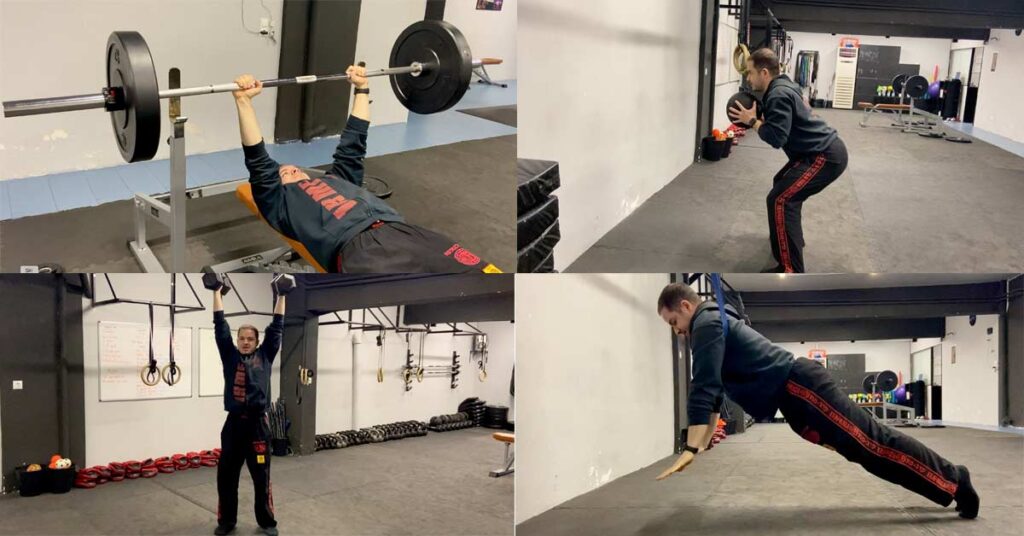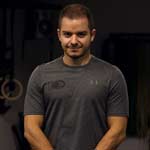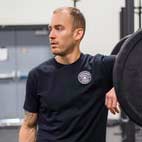
By Mike Over and Alex Chrysovergis
If you’re training for strength, power, and overall athleticism—or even if you’re just a fan of reading fitness literature—chances are you’ve heard of post-activation potentiation (PAP). This is the phenomenon by which “the contractile history of a muscle influences the mechanical performance of subsequent muscle contractions.”1 In layman’s terms, this means that by exposing a muscle to heavy loads prior to an explosive movement, we can elicit greater fast-twitch fiber recruitment and a higher degree of nervous system stimulation.
Simply put, we harness more power.
There are a few training methods that take advantage of this principle, the most common being the complex and contrast methods. Complex training involves performing a few heavy repetitions in the strength range, immediately followed by some reps of a lighter load power exercise of the same movement pattern. For example, back squats and plyometric jumps. The contrast method, on the other hand, involves switching between strength and power exercises from set to set.
French Contrast is two ‘waves’ of potentiation-based training all rolled into one big complex set. Generally, you’ll take 20 seconds between exercises and 2-5 minutes between sets. Share on XAll of this sounds great, but can we possibly do even better? Yes, we can. Enter the French Contrast Method (FCT), an advanced training protocol that combines both complex and contrast training. Research and personal experience suggest that it produces amazing results. The concept was first and foremost grasped by French track & field coach Gilles Cometti, and then it was widely popularized by Cal Dietz, the Head Olympic Strength & Conditioning Coach for numerous sports at the University of Minnesota.
Here’s a general overview of how it works. Each set involves:
- A heavy compound lift: This is a big strength movement whose purpose is to recruit as many relevant motor units as possible.
- A force-oriented plyometric movement: This typically involves a relatively longer ground contact/stretch reflex time. At this point, you should just try to produce the maximum amount of force possible on each repetition.
- A speed-strength movement: Speed-strength is all about moving at high speed with the maximum load possible.
- A speed-oriented plyometric movement: An accelerated/overspeed exercise is performed here, usually by utilizing a band to provide that extra speed boost.
All four exercises belong in the same set and represent a similar movement pattern like pushing, pulling, squatting, hinging, and so on. They should be performed in this exact order, taking only a few seconds of rest between each one.
The totality of these movements is designed to involve the whole strength-speed/speed-strength spectrum.
Programming Parameters
Now let’s elaborate on specific programming parameters.
1. Load and Reps
- For the compound lift, the load should fluctuate around 80% of your 1RM. Perform 2-3 reps. Resist the temptation to go too heavy. The purpose is to potentiate the muscles, not get gassed out. More on common mistakes later.
- In the force-oriented plyometric, simply focus on producing as much power as possible on each rep. Do 3-5 reps.
- For the speed-strength movement, use around 60% of your 1RM as a general rule, especially if you’re going to use Olympic lift variations. Keep in mind that this percentage can vary depending on the nature of the exercise. For example, other ballistic exercises like the barbell jump squat are best performed around the 30% point. The load you choose should feel heavy yet comfortable enough to be explosive. Again, do 3-5 reps.
- In the speed-oriented plyometric, focus on minimizing contact time with the ground or switching between concentric (lifting the weight) and eccentric (lowering the weight) contractions as fast as possible. Perform 4-6 reps.
2. Sets and Timing
All four of the above exercises constitute one giant set. Once more, remember that your goal is to attack every rep with full intent and aggression, not under fatigue. Therefore, perform your French Contrast sets first thing after a good, dynamic warm-up while you’re still fresh. Do not exceed 3-4 sets of any given complex in the same training session. You can program two complexes for different body parts though, such as lower and upper body.
3. Rest and Frequency
Rest around 20-30 seconds between each exercise during the set but take 2-5 minutes off between sets. The French Contrast Method is notorious for draining the lifter’s nervous system resources and causing systemic fatigue.
The French Contrast Method is notorious for draining the lifter’s nervous system resources and causing systemic fatigue… Use it in your last periodization block to peak, for no more than 3 weeks. Share on XFor this reason, you should use it in your last periodization block (realization phase) to peak, two to three times per week, and for no more than three weeks. Make sure to follow with a deload period, especially if you’re competing.
Examples
Let’s look at some examples so that the method’s modus operandi becomes crystal clear. It goes without saying that what follows is a simple demonstration of the logic behind the method. The movements can be substituted with others, sport-specific or not, to suit your needs accordingly, as long as the above conditions and principles are satisfied.
Complex 1: Hinge/Lower Body Pull
Let’s first take a look at FCT as applied to lower body pulling. This series, in particular, can help athletes with building linear acceleration and aerobic work capacity/power. The exercises are:
1A. Trap bar deadlift or RDL – 3 reps @ 80%
1B. Broad jump (high-force speed) – 3 reps
1C. Elastic resisted row – 5 reps
1D. Assisted sprint – 15-20 meters
Insert Video 1. Hinge series.
Complex 2: Squat/Lower Body Push
Here’s an example of how to apply FCT to squatting. It will help athletes immensely with vertical jumping speed and power. Here are the lifts:
1A. Safety bar box squat – 3 reps @ 80%
1B. Hurdle hops – 3 reps
1C. Sled push resisted x 20m
1D. Assisted squat jumps – 5 reps
Insert Video 2. Squat series.
Complex 3: Upper Body Push
This is an example of FCT applied to upper body pushing. It will tremendously help athletes required to throw/push/punch in their sport. Here’s what it includes:
1A. Close grip barbell bench press – 3 reps @ 80%
1B. Med ball chest pass – 5 reps
1C. Dumbbell push press – 5 reps @ 60%
1D. Band-assisted plyo push-up – 5 reps
Insert Video 3. Upper body push series.
Complex 4: Upper Body Pull
As far as functional movements are concerned, this list would not be complete without a pulling-focused complex. Athletes who drag/pull/grapple in their sport will find this extremely useful. The exercises are:
1A. Weighted pull-up – 3 reps @ 80%
1B. Plyo inverted row – 5 reps
1C. Ball slam – 5 reps
1C. Band-assisted pull-up – 5 reps
Video 4. Upper body pull series.
Common Mistakes
By now you should have a good idea of how to program FCT. Now let’s look at some common mistakes you’d best avoid.
1. Not Choosing the Correct Weight
A lot of times, people do French Contrast wrong because they see it as an opportunity to load up the weight and create high degrees of stress and tension and even go to near failure for 8+ reps.
This is counterproductive for an athlete trying to get stronger and faster. The context of their sport and the athlete’s goals help identify the loading schemes and range of motion. If you are a sprinter trying to boost acceleration, why in the world would you feel the need to squat ass to grass with 1-3 rep maxes? You want to maximize the potentiation effects of your big strength lift, so you don’t want aggressive fatigue coming from the main lift. The same applies for deadlifts from the floor or raised. You must use the correct scenario for each particular athlete and their goals.
Additionally, acceleration doesn’t happen with perpendicular shin angles, so take that note into account when doing your movements.
2. You Rest Like a CrossFit Lifter or a Bodybuilder
You are training for performance, but you are not trying to drive so much lactate to your muscles you can’t move the next day!
On the flip side, you will be out of breath. That’s normal. However, we’re here to get strong and fast, so sucking wind for 2-3 minutes between exercises would be a sign you need to go back to base one and touch up your conditioning work.
French Contrast is two “waves” of potentiation-based training all rolled into one big complex set. Generally, you’ll take 20 seconds between exercises and 2-5 minutes between sets.
3. Poor Exercise Selection
Most people will just turn to the standard box jump for the choice to contrast the main lift. While it can help, you need to think more outside the box (no pun intended) and utilize more exercises that relate to the athlete’s needs. Other options can include hurdles, bounds, even depth jumps and band-assisted/-resisted jumps.
Are they in a frontal plane sport? Have lateral-based movements. Additionally, the key is to not gas yourself on the big lift so your plyometric is not at a high work rate.
4. Trying It with a Low Training Age
While seeing this on YouTube and Instagram might be exciting for the young athlete, it can be a waste of time. Doing the French Contrast Method without developing basic levels of strength and power would be like trying to add a spoiler and turbo to your ’95 Toyota in the hope of kickstarting the engine’s speed.
Doing French Contrast without developing basic levels of strength and power would be like traying to add a spoiler and turbo to your ’95 Toyota in the hope of kickstarting the engine’s speed. Share on XIt’s just not ready for it.
Rate of force development (RFD) within a muscle requires various levels of motor unit contractions. They can be either isometric or ballistic contractions. However, the point of RFD is understanding that high initial motor unit release plays a critical role to reach a high rate of force development. This means that if an athlete cannot recruit the most motor units, their RFD will be impacted, making it a poor choice for low-skill newbies.
5. Using for 3+ Weeks
While this strategy is highly advantageous to use even closer to competition, it is not something you want to continue to do for extended periods of time. It is perfect for building to peak week.
The best way to use French Contrast training is as a form of periodized block training and cycle it in 3-4 weeks prior to your event or competition. The goal of FCT is not muscular growth, so if your goal is to add slabs of muscle, I wouldn’t count on this to get you there.
French Contrast Takeaways
For FCT, potentiation is the underlying physiological mechanism that theoretically makes this set structure effective. This is when a conditioning exercise—commonly a heavy loaded compound movement—serves to increase the performance of a subsequent exercise, commonly a lower-load, higher-velocity exercise. French Contrast is a great way to take potentiation and alternate between high force and high speed.
While this method tends to work much more efficiently with higher-skill lifters, it has been tested with lower-skill beginners, and there is some suggestion that if they are above novice, a slight drop in intensity (think RPE 6-7) and a slight increase in the reps performed can have some merit. This is ultimately up to the discretion of the coach. Beginners need to be focused on motor learning, recruitment, and proprioception before working such high training variations.
One big thing to remember that is often underappreciated is that in sports and training, many scenarios involve performing while fatigued. That is one area where the French Contrast can help and give a proper synergy to real-life situations.
Adding French Contrast training can fire up metabolic capacity and enhance the overall work capacity of your training session by getting more work done in less time. Share on XAbove all, FCT is a solid way to stay young and agile if you’re over 40. In particular, most men after this age begin losing motor units and growth hormone. Adding FCT can fire up metabolic capacity and enhance the overall work capacity of your training session by getting more work done in less time.
If you find yourself needing to show up your old high school buddies in a summer basketball league this year, give this method a try 3-4 weeks leading up to your season.
Since you’re here…
…we have a small favor to ask. More people are reading SimpliFaster than ever, and each week we bring you compelling content from coaches, sport scientists, and physiotherapists who are devoted to building better athletes. Please take a moment to share the articles on social media, engage the authors with questions and comments below, and link to articles when appropriate if you have a blog or participate on forums of related topics. — SF
References
1. Lorenz, D. “Postactivation Potentiation: An Introduction.” International Journal of Sports Physical Therapy. 2011;6(3):234–240.
 Alex Chrysovergis is a self-defense instructor and strength and conditioning coach. He’s the owner of Streetwise Krav Maga, a leading reality-based self-defense and fitness school in Greece.
Alex Chrysovergis is a self-defense instructor and strength and conditioning coach. He’s the owner of Streetwise Krav Maga, a leading reality-based self-defense and fitness school in Greece.


Sled push at 60% RMSL? I’m right?